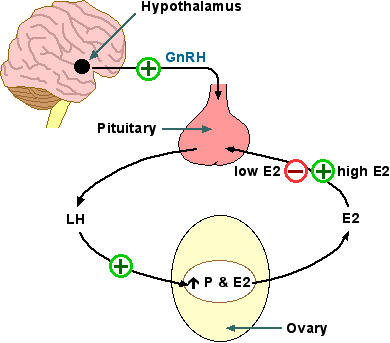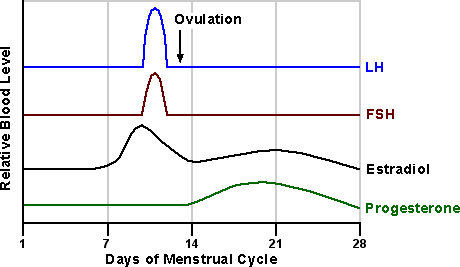I. The Female Reproductive System  top
top
| Figure 23.1 Feedback Control of Ovarian Hormone Production |
 |
- Feedback Control of Ovarian Hormone Production
- The pathway leading to the secretion of female steroid sex hormone begins in the hypothalamus, with secretion of the releasing hormone GnRH (gonadotropin-releasing hormone)
- GnRH stimulates the pituitary to release FSH and LH
- FSH and LH stimulate production of sex steroids, estradiol - the most common estrogen (E2 in Figure 23.1) and progesterone (P in Figure 23.1)
- Negative and positive feedback by estradiol and progesterone controls FSH and LH production:
- Low levels of E2 and P cause negative feedback to inhibit FSH and LH secretion
- High levels of E2 and P stimulate FSH and LH secretion
- The Menstrual Cycle
| Figure 23.2 The Menstral Cycle |
 |
- Follicular phase
- The menstrual cycle begins as FSH stimulates development of an ovarian follicle. As this follicle matures, it begins producing a small but steadily rising amount of estradiol. This low level of estradiol causes:
- Negative feedback: inhibition of FSH and LH secretion
- Growth of the lining of the uterus
- Ovulation
- The amount of estradiol secreted at mid-cycle has increased to the high level that stimulates a surge of FSH and LH release by the pituitary
- The LH surge causes ovulation: the follicle ruptures and releases its egg near the opening of its fallopian tube
- Luteal Phase
- Following the release of its egg, the follicle changes into a hormone-secreting structure, the corpus luteum, and secretes estradiol and progesterone in response to LH.
- Estradiol and progesterone stimulate the continued development of the lining of uterus
- If pregnancy does not occur, the corpus luteum eventually disintegrates and stops secreting estradiol and progesterone. The uterine lining sheds and menstruation occurs.
- If pregnancy occurs, the placenta produces hCG (human chorionic gonadotropin) which maintains corpus luteum's secretion of progesterone
- At 3 months gestation, the placenta takes over secretion of progesterone
II. The Male Reproductive System  top
top
- Feedback Control of Testicular Hormone Production
- As in the female reproductive system, GnRH stimulates the pituitary to release FSH and LH
- FSH stimulates the cells of the seminiferous tubules to produce sperm.
- LH stimulates the interstitial cells of the testes to produce androgens.
- Androgens also stimulate the production of sperm
- Androgens exert negative feedback on the production of GnRH, FSH, and LH.
- FSH and LH also exert negative feedback on GnRH production.
- In human males, these feedback loops keep androgen levels relatively stable.
 Quick Question Quick Question  |
Question:
What would happen if a woman begins taking a regular, low dose of estradiol at the start of her menstrual cycle (when her own estradiol production is extremely low)?
CLICK HERE FOR ANSWER
|
End of page  top
top
![]() top
top


![]() top
top
![]() top
top